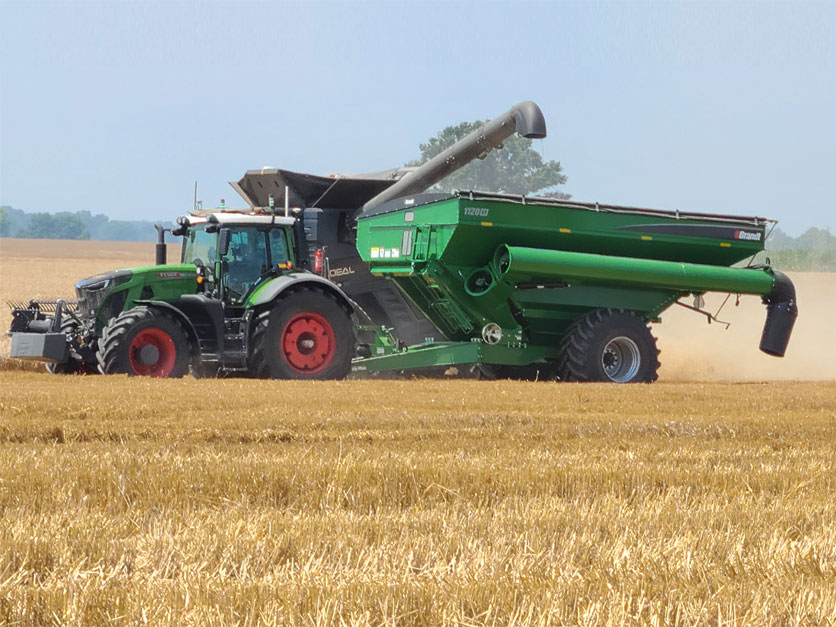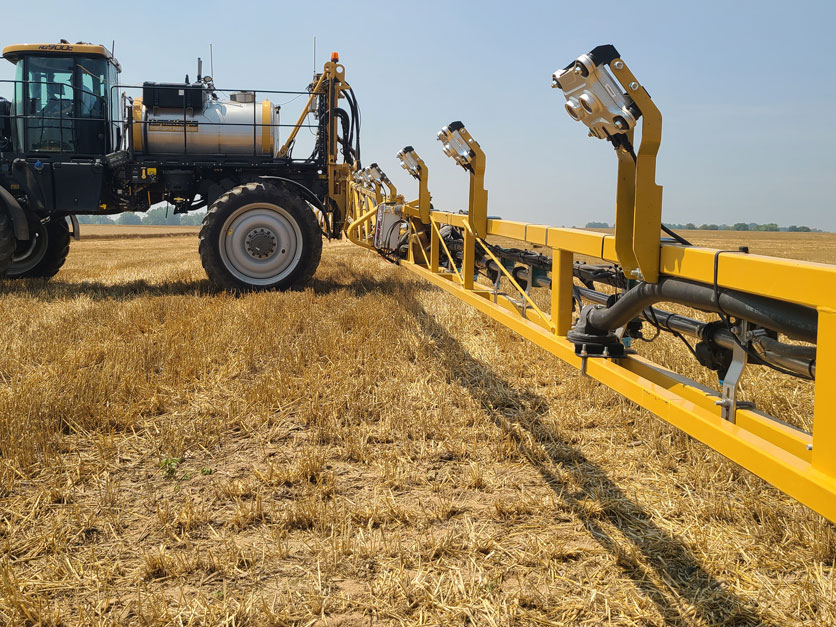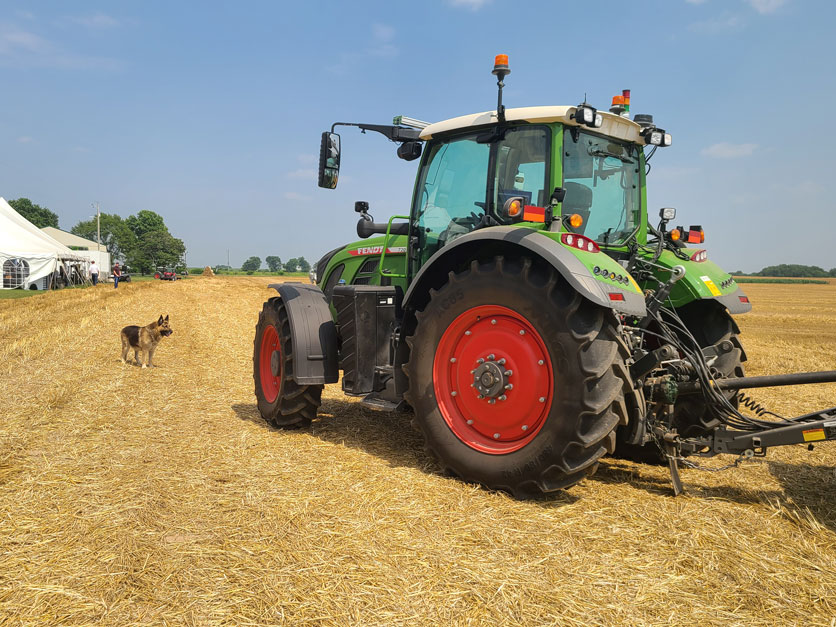At AGCO, two big engines of innovation for the farm equipment company emphasize a path to fully autonomous and clean energy solutions for farmers in the firm's quest to help increase net farm income 20%.
During a recent on-farm media event in Kentucky, AGCO offered a hands-on look at several pieces of equipment the company plans to roll out in the next several years, as it seeks to offer fully autonomous solutions by 2030 across the entire farm value chain – starting with soil and seed preparation, planting, fertilizing, spraying, harvesting and grain storage.
In the next one to three years, AGCO plans to introduce for the North American marketplace a fully autonomous grain cart and tractor for use at harvest, an autonomous baler and tractor, AI weed sensing technology on sprayers, targeted fertilizer applications, self-adjusting planter technology and a fully electric small horsepower tractor. The potential savings? As much as 21% on hired labor, 28% in crop protection, and 5% on fertilizer, as measured at the Kentucky farm.
That wheat farm showcased the need for many different pieces of equipment running in tandem and spotlighted the technological solutions on the way. On one side of the farm was a combine harvesting wheat, followed by a planter immediately planting double-crop soybeans, the need to spray for weeds, as well as baling wheat straw that is a byproduct from harvesting.
“Every automated feature that we put in, whether it's on a new machine, or a retrofit solution, is purely based on farmer economic improvement," said Eric Hansotia, AGCO's chairman, president and CEO.
In May, AGCO reported first quarter 2023 sales growth of 24%, with a third straight quarter of operating margins above 10.5%.
Unlike other companies in the large farm equipment space, AGCO allows its products to be used as a retrofit on competitor’s equipment, such as a John Deere planter or Case IH sprayers, as well as its own line of equipment with Massey Ferguson and Fendt.
Hansotia said he sees AGCO’s retrofit and machine sales divisions as growth businesses.
“Retrofit has never had a down year,” he said. In a tighter economy farmers may not buy a $400,000 piece of equipment, but they may be willing to spend $100,000 on upgrades. AGCO aims for a one- to two-year payback on investments for farmers to drive adoption, he said.
“Precision Planting is always our cutting-edge sharp edge of the spear on technology,” Hansotia said. “We always come to the market first there. And then after it’s matured for two to three years, then we’ll put it in the factory and make it broad-based” across AGCO’s equipment lines.
Hansotia expects AGCO’s Fendt tractor segment to continue to grow. It saw its sales in the Fendt brand increase by 139% in North America in the first quarter, and 94% in South America. Fendt and Challenger sales in North and South America are expected to double over the next four to six years, he added.
Autonomous grain cart
One task AGCO identified within its strategy of providing autonomous solutions is the tractor-pulled grain cart that moves beside the combine during harvest and then unloads at a grain truck. At harvest, an operation requires many workers than at any other time of the year.
Grain cart operators often spend a lot of time sitting and waiting in a field while the combine runs, but freeing up this position allows that employee to be driving a grain semi-truck or doing other tasks on the farm.
The product, in its beta stage in 2024 and scheduled for limited rollout in 2025, is a retrofit system which allows it to be used on any tractor. The grain cart is programmed to come alongside the combine, which the combine operator can also control from the cab of the combine to speed up or slow down, and then drives without an operator seated in the cab to the grain truck at a specified location and on a specified path through the field to minimize compaction over the same path.
 One task AGCO identified within its strategy of providing autonomous solutions is the tractor-pulled grain cart that moves beside the combine during harvest and then unloads at a grain truck.
One task AGCO identified within its strategy of providing autonomous solutions is the tractor-pulled grain cart that moves beside the combine during harvest and then unloads at a grain truck."The goal for the autonomous grain cart is to keep the combine moving and grain trucks transporting as well,” said Darcy Cook, general manager of JCA Technologies, a recent acquisition of AGCO from Canada that AGCO identified as an emerging leader in autonomous and connected agriculture machine control systems.
Don’t miss a beat! It’s easy to sign up for a FREE month of Agri-Pulse news! For the latest on what’s happening in Washington, D.C. and around the country in agriculture, just click here.
AGCO estimates by removing bottlenecks in grain harvest within its combine and an autonomous grain cart, it can offer a 33% increase in harvest efficiency and provide a 9% boost in net farm income for the Kentucky sample operation.
If a farmer doesn’t have a grain cart driver all the time, or even 50% of the time, which is common on many farms, 33% of that operation's crop would be harvested too late, resulting in a 10% loss on that third of their crop. Cook said the savings of spillage is another benefit of the autonomous grain cart, which has a perfect record of never spilling any grain.
Cook said the autonomous framework consists of high-end processing systems, advanced sensors and AI machine learning capabilities in the communications systems, which are installed into the tractor to tie into the drive-train system to control the steering propulsion braking system.
Cook said many of the building blocks of the autonomous systems can be used through different applications.
“So even though this system has a very specific user experience for the autonomous grain cart operation, it still needs perception systems and guidance and navigation and mission management. And these are building blocks that have been refined and increase with robustness through using a variety of different applications,” he said.
Weed sensing technology
Another focus in the transition to autonomous at AGCO is how farmers manage weeds.
Today, producers spend $50 to $70 per acre on crop protection products for insecticide, herbicide and fungicide. AGCO’s Symphony Vision retrofit suite of products uses camera technology and AI which allows for the right rate, placement, source and time to combat weeds. This can help save money for producers and creates less potential impact on the environment from overuse or runoff.
“It intelligently applies the right rate of herbicides and only where it’s needed,” said Jason Stoller, senior manager, product engineering at Precision AGCO.
 AGCO’s Symphony Vision retrofit suite of products uses camera technology and AI which allows for the right rate, placement, source and time to combat weeds, allowing farmers to apply fewer crop protection products.
AGCO’s Symphony Vision retrofit suite of products uses camera technology and AI which allows for the right rate, placement, source and time to combat weeds, allowing farmers to apply fewer crop protection products. Today, most farmers blanket spray an entire field at a set rate. Stoller said the new technology allows not only for variable rates – if, for instance, weeds are thicker – but can be turned off if no weeds are present.
The weed sensing technology takes images 3 feet to 12 feet ahead of the sprayer boom where the herbicide is eventually sprayed. The AI cameras look ahead and process the images and determine what is a weed and what’s not. That is then communicated through the nozzle control and applied based on the camera data. Stoller said the target speed is 15 mph, with trials now running between 5 to 10 mph.
Justin McMenemy, vice president of disruptive products at Precision AGCO, said the technology is so complex to work in the microseconds for making the decisions as the images are taken and decisions made on application levels.
McMenemy said AGCO is within a couple years of commercializing the product with corn, cotton and soybean growers as initial targeted crops, with as many as 25 crops able to use the technology. Precision Planting will offer the retrofit option for two to four years before rolling it out to AGCO’s line of sprayers. No price has been set yet, but AGCO hopes it pays for itself in the first year to two years and generate revenue for the grower after that period.
“The ability to offer technology and get it on farms across America in the next five years, the only way to do that is really to be able to get that on the piece of equipment they already own,” McMenemy said.
Automated baler
Another autonomous technology in development by AGCO is its virtual driver baling system, which has a projected 2025 rollout. It includes collision avoidance and windrow detection and guidance.
Kai Saworski, director of product management at Green Harvesting, said there is 25% of the grain value in wheat straw. Operations can lose 50% or more of the value of that wheat straw with a single rain event if there isn’t someone to run a baler, Saworski said.
Wheat fields provide income from both the wheat grain harvested and wheat straw baled.
“It's not really this labor cost itself that you save, it's the security that you have machines running when you need,” he said.
 AGCO's autonomous tractor encountered a dog in its path and stopped automatically
AGCO's autonomous tractor encountered a dog in its path and stopped automatically
Audrey Guillet, manager of research and advanced engineering of systems architecture, said the autonomous driving system for baling splits the process into subtasks. Route planning is developed based on where the combine drove and recorded in its internal data collection and spits out the wheat straw and establishes a preliminary line for where to bale and where to turn.
The tractor has a laser imaging, detection and ranging (LIDAR) sensor on top of the cab that also detects the swath of straw to be baled and also has collision avoidance.
Clean energy solutionsAGCO has also focused on research and development in alternative power technologies that help improve farmer profitability but also meet the sustainability and environmental requirements pushed by a growing number of regulations around the world.
“Carbon neutrality and your carbon footprint is on the radar for everybody,” said Leo von Stillfried, Director of Product Management, at Fendt. Different alternative fuel sources have varying applications and limitations as AGCO looks to a combination of biofuels, biogas, hydrogen and electric options to run its machinery.
A fully electric tractor, the Fendt E100, plans to hit the European market in 2024 and North American in 2025, which offers five hours of working time and can recharge 80% in 40 minutes. Rawley Hicks, director of product management at AGCO, said farmers can easily charge the tractor with a nearby power source, such as a grain bin site. It offers an 8- to 10-year battery life.
Due to the size and weight of the battery needed, the first iteration of the electric tractor is a 67-horsepower product, and ideal for greenhouse, specialty crop, livestock or municipality customers, von Stillfried said. Additional platforms up to 150 horsepower are projected for launch through 2030, although von Stillfried said larger electric horsepower tractors required for planting and tilling fields is just not reasonable because of the needed power.
Hicks said as higher horsepower levels are needed, that’s where AGCO will explore battery fuel cell electric solutions or renewable fuels and hybrid solutions for combustion engines to help lower emissions.
Hansotia said he believes the clean energy portfolio offers savings for producers to save on fuel, but some producers such as wineries may buy it for the sustainability image it can bring to their operations. He also said he believes some growers will choose to look to alternative fuel solutions due to government policy, either through incentives on the front end or regulations requiring electric use such as in California.
For more news, go to www.Agri-Pulse.com.


